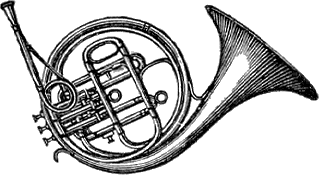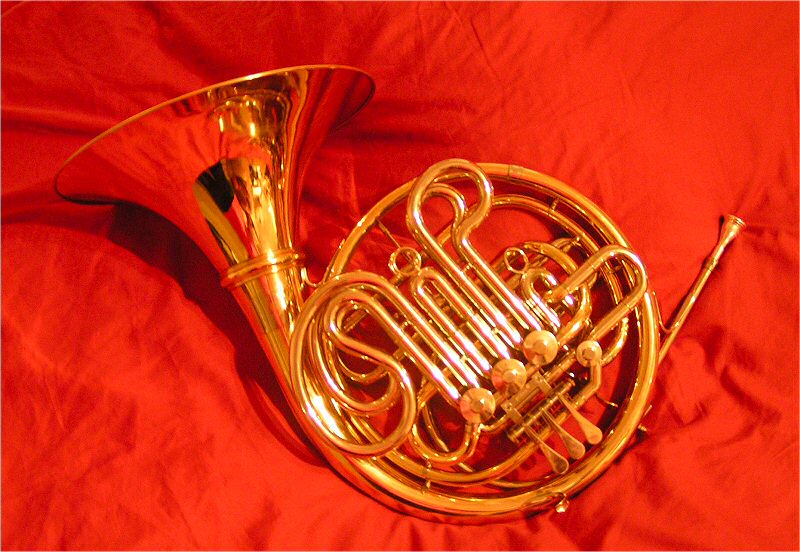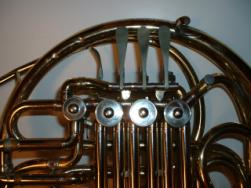French horn
The horn is a brass instrument consisting of tubing wrapped into a coiled form. Many people call this instrument the French horn, although this usage is uncommon among players of the instrument. In other languages, the instrument is named Horn, corno (plural corni), cor, etc.
Compared to the other brass instruments commonly found in the orchestra, the typical range of the French horn is set an octave higher in its harmonic series, facilitated by its small, deep mouthpiece, giving it its characteristic "mellow" tone. The typical playing range of a French horn goes from the written F at the bottom of the staff in bass clef to the C above the staff in treble clef.

History
The original French horns were much simpler than current horns, which consist of complicated tubing and a set of 3 to 5 valves (depending on the type of horn). These early horns were simply brass tubing wound a few times and flared into a larger opening at the end (called the bell of the horn). They evolved from the early hunting horns and, as such, were meant to be played while riding on a horse. The hornist would grip the horn on the piping near the mouthpiece and rest the body of the horn across his arm so that only one hand was needed to play and the other could be free to guide his steed. The only way to change the pitch was to use the natural harmonics of that particular length of tubing by changing the speed at which the lips vibrated against the mouthpiece.
Later, horns became interesting to composers, and were used to invoke an out-of-doors feeling and the idea of the chase. Even in the time of Wolfgang Amadeus Mozart, however, the horn player (now a part of the early orchestra) still had a much simpler version of the horn; he carried with him a set of crooks, which were curved pieces of tube of different length which could be used to change the length of the horn by removing part of the tubing and inserting a different length piece. The player now held the horn with both hands, holding the tubing near the mouthpiece with one, and putting the other into the bell, which was either rested upon the right knee of the player or the entire horn was lifted into the air. Now the pitch played could be changed in several ways. First the player could change the harmonic series which the instrument as a whole had by removing and inserting different sized crooks into the instrument, changing the length of the horn itself. Less globally, given a particular crook, the vibration of the lips could be varied in speed, thus moving to a different pitch on the given harmonic series. Finally, now that the player had his hand in the bell, the hand became an extension on the length of the horn, and by closing and opening the space available for air to leave the bell, he could bend the pitch to interpolate between the elements of a harmonic series. This interpolation finally made the horn a true melodic instrument, not simply limited to a harmonic series, and some of the great composers started to write concerti for this new instrument. The Mozart Horn Concerti, for example, were written for this type of horn, called the natural horn in the modern literature.
Around 1815, the horn took on new form, as valves were introduced, which allowed the player to switch between crooks without the effort of manually removing one from the horn and inserting a new one. At this same time, the standard horn came to be the horn on the F harmonic series, and there were then three valves added to it. Using these three valves, the player could play all the notes reachable in the horn's range.
Types of horns

The single F horn, despite this improvement, had a rather irksome flaw. As the player played higher and higher notes, the distinctions a player had to make with his or her embouchure from note to note became increasingly precise. An early solution was simply to use a horn of higher pitch -- usually B-flat. The relative merits of F versus B-flat were a hotbed of debate between horn players of the late nineteenth century, until the German horn maker Kruspe produced a prototype of the "double horn" in 1897.

The double horn combines two instruments into one frame: the original horn in F, and a second, higher horn keyed in B-flat. By using a fourth valve operated by the thumb, the horn player can quickly switch from the deep, warm tones of the F horn to the higher, brighter tones of the B-flat horn (commonly called "sides"). In the words of Reginald Morley-Pegge, the invention of the double horn "revolutionized horn playing technique almost as much as did the invention of the valve." [Morley-Pegge, "Orchestral," 195]
Specialized horns
While most modern instruments are of the F/B-flat double horn variety, various special-purpose instruments are available (usually at a very high price).
The most common is the descant horn, which is a single horn pitched in F alto, one octave higher than the traditional F horn. The descant is used largely for extended playing in the high register, such as in Bach's Brandenburg Concerti. Double horns in B-flat/High F (or High E-flat) are increasingly popular for works that only use the upper and upper-middle registers of the instrument.
Single horns in F or B-flat still see use, notably in operatic settings. Their lighter weight renders them much more suitable for the extended and strenuous playing required of Wagnerian operas.
The triple horn is the result of merging an F/B-flat double horn with an F-alto descant, adding a fifth valve to an already complex instrument. While the horn is suitable for work in nearly every register of horn literature, the added weight makes it tiresome to play, and for this reason it is not widely used.
The Viennese Horn is a horn traditionally played in the Vienna Philharmonic. It is a standard single horn with a dual piston mechanism for each valve. This page shows a bit more about the differences between this and the other horns listed above.
The Wagner tuba is an instrument generally played by the horn players of the orchestra which resembles a mix of a horn and a tuba.
The Alpenhorn is most famous from the Ricola commercials. It has been said that the horn soli section in Brahms' first symphony was inspired by this instrument.
The mellophone is, in appearance, very different from any of the above types of horn, but it is nevertheless used in place of the horn in marching bands. In fact marching band is the only connection between the horn and the mellophone. This instrument is harmonically much more similar to an elongated trumpet.
Horn techniques
Double/triple tonguing
These techniques are not unique to the horn and are applicable to most all wind instruments. Normal tonguing consists of interrupting the air stream by tapping the back of the front teeth with the tongue as said in the syllable 'da' or 'ta'. Double tonguing is alternating between the 'ta' sound and the 'ka' sound. Try saying the word kitty repeatedly to get the idea. Triple tonguing is most used for patterns of three and is made with the syllables 'ta-ka-ta' said repeatedly.
Stopped horn
This is the act of fully closing off the bell with the right hand or a special stopping mute. This results in a somewhat nasal sound. The usual notation is a '+' above the note followed by a 'o' above notes that are open. For longer stopped passages the word is just written out. Below is a list for different languages:
- English: stopped ... open
- German: gestopft ... offen
- Italian: chiuso ... aperto
- French: bouché ... ouvert (not to be confused with cuivre which means brassy.)
There is some debate as to how to finger the stopped note, as well as to how stopped horn works acoustically. Some horn players claim that stopping a note raises the pitch by a half-step. Think of the act of stopping as shortening the total length of the horn. Others say that slowly closing the bell of the horn with the hand gradually lowers the pitch to 1/2 step above the next lowest harmonic, resulting in a harmonic series that is, in effect, 1/2 step higher than the open series. In either case, to play the written pitch, the player must finger a half step below the note. Stopping must always be done on the F horn in the middle register as the Bb horn generally does not work for common notes (see fingering chart for acceptable notes to stop on the Bb horn). Some Bb horns do help this by having an A stopping valve. In the upper register, however, experimentation with fingerings on the Bb horn can yield more secure notes without sacrificing good intonation.
There is also an effect that is occasionally called for, usually in French music, called "echo horn", "hand mute" or "sons d'écho" (see Dukas Sorcerer's Apprentice) which is like stopped horn, but different in that the bell is not closed as tightly. The player closes the hand enough so that the pitch drops 1/2 step, but, especially in the middle register, this is not closed as tightly as for stopped horn. (Note the difference: in stopped horn the bell is closed very tightly, and the pitch drops to 1/2 step above the next lowest harmonic, which can be as much as a major third, depending on register; in echo horn, the pitch drops only a total of 1/2 step, because the player does not close the bell as much) Consequently, when playing echo horn, the player fingers one half step higher. This is a source of much confusion to younger players, especially ones whose hands are not big enough to close the bell all the way for stopped horn, so they erroneously close the bell insufficiently and finger 1/2 higher.
Muted horn
Some confusion arrives when a composer marks a passage muted but also puts '+'s above the notes. This is usually a typographical error or a lack of understanding the difference between stopped horn and muted horn by the composer. Muted horn is just the use of a mute in the horn. It is therefore impossible for a note to be stopped and muted simultaneously. For marking this in music the following are used:
- English: muted ... open (or remove mute)
- German: gedampft ... dampfer weg
- Italian: con sordino ... senza sordino
- French: avec sourdine ... enlevez la sourdine
Handhorn technique
Before the advent of the valve horn players could increase the number of notes the could play beyond the normal harmonic series by changing the position of the hand in the bell. This resulted in a near chromatic range from the horn midrange and up.
Transposition
Many older pieces for horn were written for a horn not keyed in F as is standard today. As a result a requirement for modern orchestra hornists is to be able to read music directly in these keys. This is most commonly done by transposing the music on the fly into F. Commonly seen transpositions include:
- Bb alto – up a perfect fourth
- A alto – up a major third
- G – up a major second
- E – down a minor second
- Eb – down a major second
- D – down a minor third
- C – down a perfect fourth
- Bb basso – down a perfect fifth
Some less common transpositions include:
- Ab alto – up a minor third
- Gb – up a minor second
- Db – down a major third (used in some works by Berlioz, Verdi and Strauss (Der Rosenkavalier))
- B – down a tritone (used by Brahms)
- A basso – down a minor sixth (used in some works by Verdi)
- Ab basso – down a major sixth (used in some works by Verdi)
- G basso – up a minor seventh (used in some works by Verdi)
It has been speculated that one of the reasons Brahms wrote for horn in B was to encourage the horns to use the natural horn since it is so awkward to transpose a tritone down. He did not like the sound of the new valved horns. One example showing this is when Brahms picked the second horn player, Wilhelm Kleinecke, in the Vienna Opera for a performance of the Horn Trio in E flat, op. 40 over the first horn, Richard Lewy, because Lewy only played the valved horn. (Here is an article about the Brahms Horn Trios.)
Sometimes it is ambiguous to know if a piece should be transposed up or down (i.e. Bb alto versus Bb basso when only Bb is written). It is usually safe to assume the most common transposition and the most reasonable (i.e. it stays in the normal horn range). From the history of the composer more can be decided (i.e. Verdi and opera composers used many low and odd transpositions). Much experience is needed to decided this in the end.
Multiphonics
Multiphonics is the act of producing more than one pitch simultaneously on the horn. To do this one note is produced as normal while another is sung. Doing this it is quite difficult to produce an aesthetically pleasing sound, but nonetheless can be done. Like other wind instrument techniques, it is not unique to the horn. One of its earliest uses however occurs in the Concertino for Horn and Orchestra by Carl Maria von Weber.
Circular breathing
Information on this subject can be found at the article on circular breathing.
Tips and tricks
- Quick valve water emptying
- Every horn is different and every hornist must learn how to get the water out of their instrument. This trick however is nearly universal across all standard double horns. Hold the horn so the bell is up in the air. Press down the third valve and flip the first and second while rotating the horn back to the normal position. All the water in the valves is now in the third valve tubing.
- Fake high C
- On some horns a high c can pop out while pressing the first valve down halfway. This is not recommended for performance as the tone quality of this note suffers. A way to try it is to play a normal third space c on the f side and slowly press down the first valve. (discussion)
- Making screens vibrate
- A player who looks at a computer screen will sometimes see it vibrate. The effect results from the player's eyes vibrating.
Fingering chart

Well-known horn players
Use of the French horn in jazz
The horn is used only rarely in jazz, but there have been a few notable players:
Pieces for horn
- Johann Georg Albrechtsberger: Concerto in F minor for horn and orchestra
- Hermann Baumann: Elegia, for solo natural horn
- Ludwig van Beethoven: Sonata for Piano and Horn, Op. 17
- Vicenzo Bellini: Concerto in F major for horn and orchestra
- Johannes Brahms:Horn Trio in E flat, op. 40
- Benjamin Britten: Serenade for Tenor, Horn and Strings
- Emmanuel Chabrier: Larghetto for horn and orchestra
- Reinhold Gliere: Concerto op. 91 in B minor, for horn and orchestra
- Michael Haydn: Concertino for 2 horns and orchestra
- Joseph Haydn: Concerto in E flat major for 2 horn and orchestra
- Joseph Haydn: Horn Concerto No. 1
- Paul Hindemith: Concerto for horn and orchestra
- Paul Hindemith: Sonata for Horn
- Franz Anton Hoffmeister: Romance for 3 horn and orchestra
- Heinrich Hübler: Concerto for 4 horn and orchestra
- Leopold Mozart: Sinfonia da Caccia in G major "Jagdsinfonie" ("Hunting Symphony"), for 4 horns, ammunition boxes, and string orchestra
- Wolfgang Amadeus Mozart: Horn Concerto No. 1 in D major K. 412 (in two movements)
- Wolfgang Amadeus Mozart: Horn Concerto No. 2 in E flat major K. 417 (in three movements)
- Wolfgang Amadeus Mozart: Horn Concerto No. 3 in E flat major K. 447 (in three movements)
- Wolfgang Amadeus Mozart: Horn Concerto No. 4 in E flat major K. 495 (in three movements)
- Wolfgang Amadeus Mozart: Concert Rondo for horn and orchestra in E flat major, K. 371
- Francis Poulenc: Elegy for horn and piano
- Joseph Reicha: Concerto op.5, for 2 horns and orchestra
- Antonio Rosetti: Concerto No. 6 in E for horn and orchestra
- Camille Saint-Saens: Morceau du Concert for horn and orchestra
- Camille Saint-Saens: Romance Op. 36, for horn and orchestra
- Robert Schumann: Konzertstück ("concert piece") in F major op. 86 for 4 solo horns, piccolo, 2 flutes, 2 oboes, 2 clarinets, 2 bassoons, 2 horns (ad lib.), 2 trumpets, 3 trombones, timpani and strings
- Carl Stamitz: Concerto in E flat for solo horn, 2 flutes, 2 horns, and strings
- Franz Strauss: Fantasie op. 6 for horn and orchestra
- Richard Strauss: Horn Concerto No. 1 in E flat major, Op. 11 (1883)
- Richard Strauss: Horn Concerto No. 2 in E flat major (1942)
- Richard Strauss: Andante for horn and piano, Op. posthumous
- Richard Strauss: Introduction, Theme and Variations for horn and piano, Opus 17
- Georg Philipp Telemann: Concerto in D major for horn and orchestra
- Georg Philipp Telemann: Concerto in E flat major; Tafelmusik ("table music") for 2 horns, strings, and continuo
- Carl Maria von Weber: Concertino for horn and orchestra, Op. 45
Horn Makers
Listed below are some of the manufacturers of horns. Not all still exist today. For additional manufacturers consult this page.
|
|
